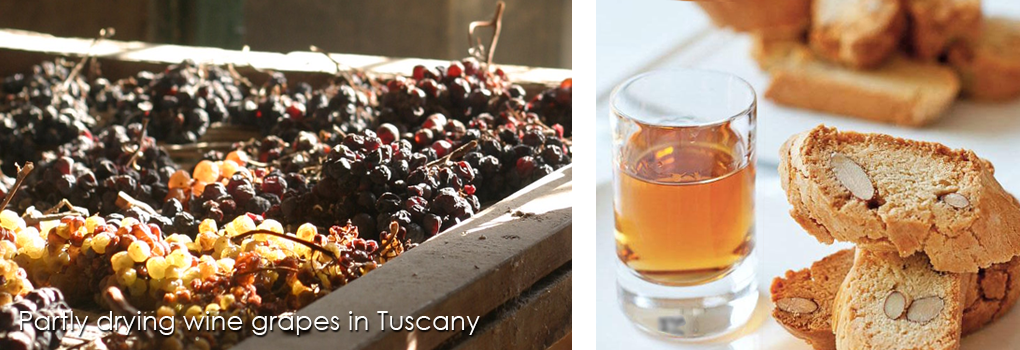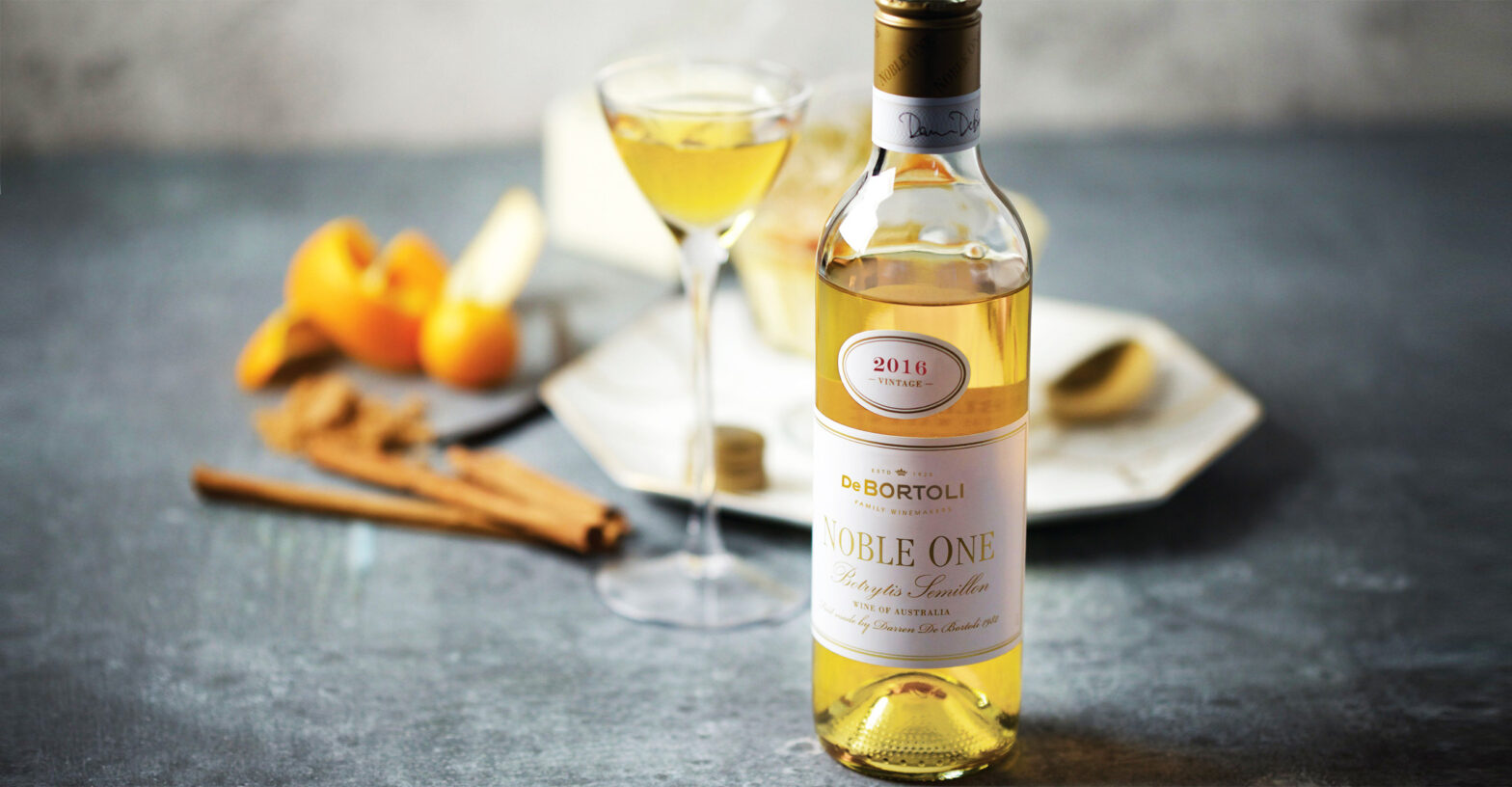Botrytis:
Botrytis Cinerea is a fungus that affects many plant species, although its most notable of hosts may be wine grapes. In viticulture, it is commonly known as 'botrytis bunch rot'; in horticulture, it is usually called 'grey mould'. The fungus gives rise to two different kinds of infections on grapes. The first, grey rot is the result of consistently wet or humid conditions, and typically results in the loss of the affected bunches.
The second, noble rot, occurs when drier conditions follow wet, and can result in distinctive sweet dessert wines, such as Sauternes or Aszu of Tokaj. The name 'Botrytis Cinerea' is derived from Latin for 'grapes like ashes'; although poetic, the 'grapes' refers to the bunching of the fungal spores, and 'ashes' just refers to the greyish colour of the spores en masse.
In the Botrytis infection known as 'noble rot' - (pourriture noble in French), the fungus spores slowly remove water from the individual grapes, leaving behind a higher percent of solids, such as natural sugars, fruit acids and minerals. This results in a more intense and concentrated juice and final wine.
Botrytis complicates the winemaking process, by making fermentation more complex. Botrytis produces an anti-fungal that kills yeast and often results in fermentation stopping before the wine has accumulated sufficient levels of alcohol. Makers of fine German dessert wines have been known to take fermenting tubs of wine into their homes to nurture the yeast through the night to assure that the alcohol level reaches legal minimums for the finally crafted product to be called wine.
Grapes typically become infected with botrytis when they are ripe, but then exposed to drier conditions become partially raisined and the form of infection brought about by the partial drying process is known as noble rot. Grapes are handpicked at a certain point during infestation can produce particularly fine, concentrated sweet wines. Some of the finest Botrytis wines are literally picked berry by berry in successive 'tris' (French for 'selections').
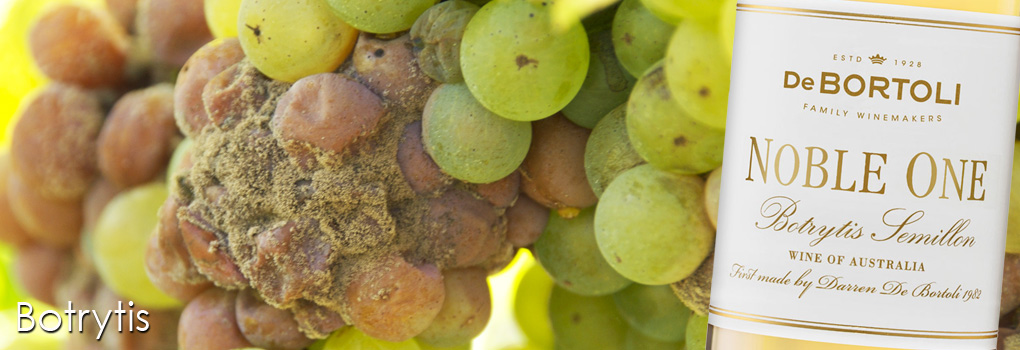
Late Harvest:
Late Harvest is a specific term applied to a wine crafted from grapes which have been left to hang on the vine longer than normal. The term Late harvest is usually used to describe a sweet wine, sometimes called a 'dessert wine', with a common example being a Late Harvest Riesling. Late Harvest grapes typically look like hanging raisins, but they have naturally dehydrated - while still hanging onto the vine.
As a result of the dehydration of water within each berry (e.g. 30-40%), the grapes now measure higher levels of natural sugar compared to a normal plump, water filled grape. So when pressed the resulting juice is much sweeter and richer than other still wines. Riesling is a typical 'late harvest' wine grape used around the world.
Other grape varietals used include: Gewürztraminer, Furmint, Muscat, Pinot Gris, Sauvignon Blanc and Viognier to name just a few.
Many of the classic examples of late harvest sweet wines come from Europe. For example, the 'Vendange Tardive' - (tranlsates to 'late harvest') are wines from the Alsace wine region in France, tend to be moderately sweet. Later harvested wines from Germany and Austria, of the 'Spätlese' and 'Auslese' designation for example, also tend to be moderately sweet.
In Germany, wines are classified according to the ripeness of the grape at the time of harvest. Within the Qualitatswein mit Pradikat classification, there are 4 levels of late harvest wines, roughly ranging from dry to very sweet: 'Spatlese' - ('late harvest'), 'Auslese' - ('selected harvest'), 'Beerenauslese' - ('selected berries harvest') and 'Trockenbeerenauslese' - ('selected dried-berries harvest') with the last two levels being grape affected by botrytis.
The resulting high sugar content in the finished wine tends to be thick, sweet and very rich; some people find late harvest wines almost cloying because of the intense sweetness, while others simply can not get enough.
Be careful when trying to pair late harvest wines with sweet desserts - as the two don't always match each other's intensity - but when matched well with selected cheeses, lighter style desserts served cold and sweet freshly cut fruits they are a perfect end to a meal - plus many are at their best when enjoyed on their own - (60mls - served in a small glass).
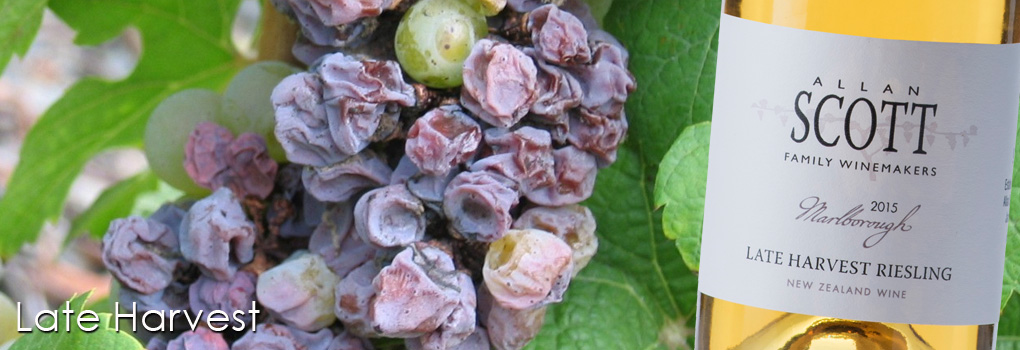
Ice Wine:
Ice wine (or in German, Eiswein) is a specific style of sweet dessert wine produced from grapes that have been frozen while still hanging on the vine.
Different from the grapes used for other styles of dessert wines, such as; Sauternes, Tokaji, or Trockenbeerenauslese. The grape for ice wine should not greatly be affected by Botrytis or noble rot at harvest time. Rather healthy grapes stay ripening on the vine until it possibly snows and then it is time to quickly harvest our ice wine.
The discovery of Ice Wine was like all good things - accidental. Due to a cooler than normal summer and an exceptionally cold winter in 1794, wine producers in Franconia - Germany, with no other choice, created an Ice Wine by pressing juice from frozen grapes.
They were amazed by the high sugar concentration in the pressed juice. It is believed around the mid 1800's, when 'Ice Wine' was started being made around the globe.
Grapes are now left on the vine well into the winter months. The resulting freezing and thawing of the grapes dehydrates and concentrates the sugars and acids inside the grapes, thereby intensifying the flavours and adding complexity. This juice is then fermented very slowly for several months, stopping naturally. Genuine Ice Wine must be naturally produced; no artificial freezing is permitted.
The Ice Wine harvest is done entirely by hand, and commences once the temperature drops below -10°C and the grapes have frozen naturally on the vines. As the nearly frozen grapes are pressed, the water portion of the juice remains within the grape skins in the form of ice crystals. A tiny but precious volume of highly concentrated juice is released.
The juice from Ice Wine grapes is about one-fifth the amount you would normally get if you pressed unfrozen grapes. To put it another way, a typical vine will normally produce sufficient grapes to make a bottle of wine; but frozen grapes will produce only one glass of Ice Wine. This helps explains the difference in price between the two.
Typical grapes used include: Riesling, Vidal Blanc and interestingly Cabernet Franc. A Cabernet Franc Ice-Wine results in a sweet wine with a light pink colour - enjoy the journey.
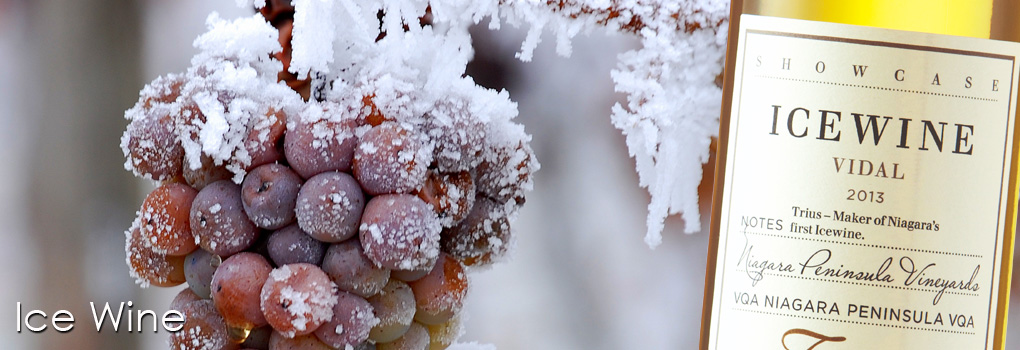
Trockenbeerenauslese:
Trockenbeerenauslese (literal meaning: selected harvest of dried berries) is a German wine term (classification) for a rich, full-bodied style of sweet dessert wine.
A Trockenbeerenauslese wine has the highest level of sugar content in the 'Pradikatswein Category' of the German and Austrian wine classification-scale. Trockenbeerenauslese wines, sometimes referred to as 'TBA' for short, are made from individually selected grapes affected by 'botrytis'. The grapes are individually hand-picked, having shriveled on the vine from the the affect of botrytis, to the point of looking like a raisin while still attached to the bunch.
They are therefore very sweet and have an intensely rich flavour, typically with a nougat or honeyed bouquet, ripe stone fruits such as sweet apricots and nectarines alike.
The finest examples are commonly crafted from Riesling grapes, as this varietal retains good levels of acidity even as it becomes extremely ripeness. Other grape varietals used include: Scheurebe, Ortega, Welschriesling, Chardonnay and Gewürztraminer - along with a few others, as they are more prone to noble rot, and they ripen earlier than Riesling.
These wines are rare and expensive due to the labour-intensive method of production, and the fact that very specific climatic conditions (which do not necessarily occur every year) are required to create grapes adequately affected botrytis. They are usually golden to deep golden honey in colour when fermented. The wine is viscous and concentrated, and arguably can be aged almost indefinitely due to the preservative aspect of its high sugar content. Although Trockenbeerenauslese has very high residual sugar level, the finest examples are far from being cloying due to their naturally high level of refreshing acidity.
The style is similar to, but much more concentrated than 'Selection de Grains Nobles' from Alsace in France. In comparison to 'Sauternes', the wines are considerably sweeter, a lower level of alcohol and are usually not oak aged. The minimum sugar content for a Trockenbeerenauslese is 150-154g/L. In exceptional years, top producers can exceed these levels, resulting in a richer, sweeter wine; they can contain 300+ g/L and may approach the very rare 'Tokaji Eszencia' in concentration - enjoy.
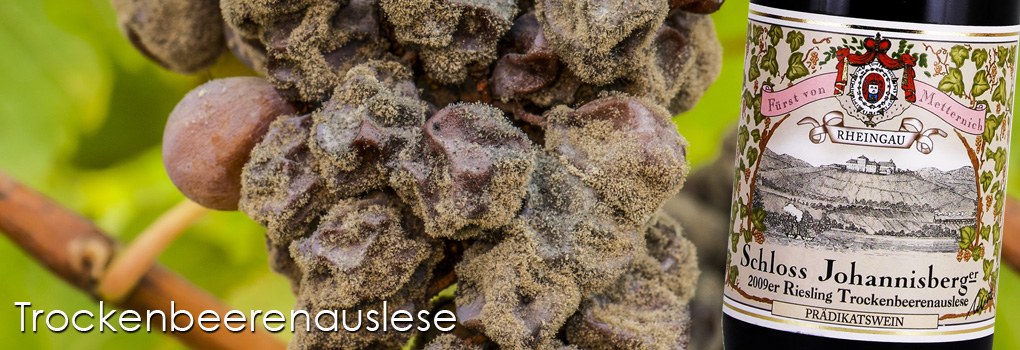
Tokaji:
Tokaji (Hungarian: Tokaj) is the name of the unique wines from the region of Tokaj-Hegyalja in Hungary. The name Tokaji (Protected Wine with Designation of Origin) is used for labeling wines from this wine district. This region is noted for its sweet wines made from grapes affected by noble rot - (botrytis), a style of wine which has a long history.
Only six grape varietals are 'officially approved' for Tokaji wine: Furmint, Harslevelu, Yellow Muscat, Zeta, Koverszolo and Kabar. Furmint accounts for 60% and is by far the most important grape in the production of Aszu wines. Nevertheless, an impressive range of different types and styles of wines are produced, ranging from dry whites to the renowned 'Eszencia' - the world's sweetest wine.
The Tokaji wine area is a small plateau, 457m above sea level, near the Carpathian Mountains. The soils are of volcanic origin, the region has a unique climate, beneficial to this particular viniculture. The grapes are left on the vine long enough to develop 'noble rot' (Botrytis cinerea). Grapes are hand harvested, sometimes as late as December (the case of true Eszencia, occasionally into January).
Eszencia: described as one of the most exclusive wines in the world, although technically it can not be called a wine because its enormous concentration of sugar means its alcohol never rises above 5-6% Alc./vol.
The sugar concentration of Eszencia is typically 500g - 700g/L; the 2000 vintage produced Eszencia exceeding 900g/L, and unlike virtually all other wines, it maintains its quality and drinkability for 200+ years.
Tokaji wine became the world's first protected appellation, established decades before Port wine, and over 120 years before the classification of Bordeaux. It began in 1730 with vineyards and specific wines being *classified into 3 strict categories; a royal decree in 1757 established a closed production district in Tokaj. The classification system was completed by national censuses of 1765 & 1772. Ideal with foie gras, aged Gouda and fruit desserts.
"A wine that would make angels sing out loud in praise" - Hugh Johnson OBE.

Passito di Pantelleria:
The history of crafting ‘Passito di Pantelleria’ is over 2000 years. Passito di Pantelleria has been produced since time immemorial from the grape varietal Zibibbo (aka: Moscato di Alessandria), and described as a unique Italian wine with a delicate aroma and its palate velvety sweet, affectionate and generous. In August 1971, it became the 3rd Sicilian wine to obtain DOC status - after Etna in August 1968 and Marsala in April 1969.
This wine is produced in several different styles; White, Moscato, Passito, Golden Moscato, Liqueur Moscato, Sparkling Moscato, Passito liqueur and Sweet Zibibbo. Pantelleria is a volcanic island located at the 36th latitude north and home to some of Europe's most southerly vineyards; only those in Crete and Cyprus lie closer to the equator.
Some of Italy’s best sweet wines come from the island Pantelleria in the Mediterranean, a volcanic island 180 km’s south-west of Sicily and just 60 km’s east of Tunisia. The island is only 15 km’s long but home to some of the world’s most unique vineyards. The islands high summer temperatures, are moderated by the surrounding sea. But a distinctive feature in its terroir is the strong hot, ‘sirocco’ winds that come across from North Africa on their way to Sicily and southern Italy. The dry heat of Pantelleria is perfect for producing the sun-dried Zibibbo grapes used to make the delicious sweet wine Passito di Pantelleria.
Vinification involves the drying of the hand-picked grapes and then fortifying for the distillation of liqueur styles, all of which must be carried out on the island of Pantelleria. The vinification and bottling of ‘Passito di Pantelleria’ must take place within designated winemaking areas. The bottling of Pantelleria, Moscato liqueur, sparkling Moscato, golden Moscato Passito liqueur, Zibibbo White sweet and even sparkling, must take place within the administrative territory of Sicily.
The production of premium Passito di Pantelleria can take a minimum of three years as of 1st September of each year - and derived from musts with a natural minimum content of 250g of residual sugar per litre, obtained by the drying of the grapes on the vine and on mats in the sun. Obtained, without any other enrichment, by means of vinous alcohol addition - or strictly calculated on the basis of 1% of pure alcohol for 17.5 grams of residual sugar per litre; with a maximum alcohol strength of 21.5% and a minimum of 14.5% and a minimum sugar content of 100 grams per litre.
Passito di Pantelleria must come from grapes in whole or in part direct from the vine or after harvesting, by drying in the sun. For these wines it is ruled out any enrichment of the grape must or wine, except for the addition, even after the 30th November each year of raisined grapes in the sun with a maximum concentration of 60% sugar. The vinification and refinement after pressing lasts for 15-18 months. This process is prolonged for another 6 months in bottle before being released onto the market.
The island of Pantelleria has been occupied by numerous cultures over time with: Phoenician, Roman, Byzantine, Arabic - and the drying of grapes and making of wine familiar to many of them. Though the modern winemaking history began in the 1980s when Marco De Bartoli began experimenting with Pantelleria fruit, with an increased freshness which represented a clear break from Pantelleria wines of the past. Followed by others who use a combination of higher altitude fruit to increase the acidity and freshness of their Passito.
Today Pantelleria has approximately 1400 hectares of planted vines farmed by some 400 growers, predominantly Zibibbo and mostly for producing wine. Growing conditions are difficult with low rainfall of only 300mm annually, with no ground water, steep terrain, with soils comprising of sand and volcanic pumice. Almost constant strong winds require that vines be planted in holes and grown close to the ground for protection. Most vines are trained 'alberello style', as the hot summer sirocco winds can cause vines to close down and fruit to prematurely dry out. A few vineyards are planted as high as 400 meters, most destined for Passito come from low-lying vineyards located close to the coast. The difficulties of vinification and quality bottling (due to lack of commercial water) on Pantelleria has resulted in many Passito wines being made in Sicily from dried grapes brought in from the island.

Spätlese Wine:
Spätlese (meaning: late harvest) is the German wine term for a wine made fully very ripe grapes - it is also the lightest style of 'late harvest' wines. Spätlese is a riper style and level above Kabinett in the Pradikatswein classification of German wines and is also the lowest level of Pradikatswein in Austria, where Kabinett is classified differently.
In the German wine classification of ripeness, the grapes with the least amount of sugar are destined for Kabinett wines. Then you have; Spätlese, and then the riper Auslese, Beerenauslese, Trockenbeerenauslese and finally Eiswein. The grapes are picked at approximately 7 days after the normal harvest date, so they are riper in character and have a higher must weight.
Because of the weather, waiting to pick the grapes later carries a risk of the crop being ruined by rain and cold weather. However, in warm years and from good sites much of the harvest will reach the Spätlese level.
The wines may be either sweet or dry (trocken); it is a level of ripeness that particularly suits rich dry wines from Riesling. At Auslese levels the alcohol levels may become very high in a dry wine leaving the wine unbalanced, making wines with some residual sweetness is preferable to many palates. However, most German wines are traditionally dry, and the amount of sugar is not the only note balancing a wine. Dry German wines can be very balanced and usually get higher reviews from German wine journalists than a comparable wine with more sugar. Many Spätlese wines will age well, especially those made from Riesling.
It is thought the beginning of Spätlese wines took place in the Rheingau winery Schloss Johannisberg in 1775, as for some reason, the courier sent out by the Abbey at Fulda was delayed for 14 days. By the time the order finally arrived botrytis (noble rot) had set in, but the harvest happened anyway, though no high hopes were placed on the wine from the shriveled, moldy grapes. The wine turned out to be surprisingly good. Schloss Johannisberg began actively seeking to produce late harvest - Spätlese wines affected by botrytis.
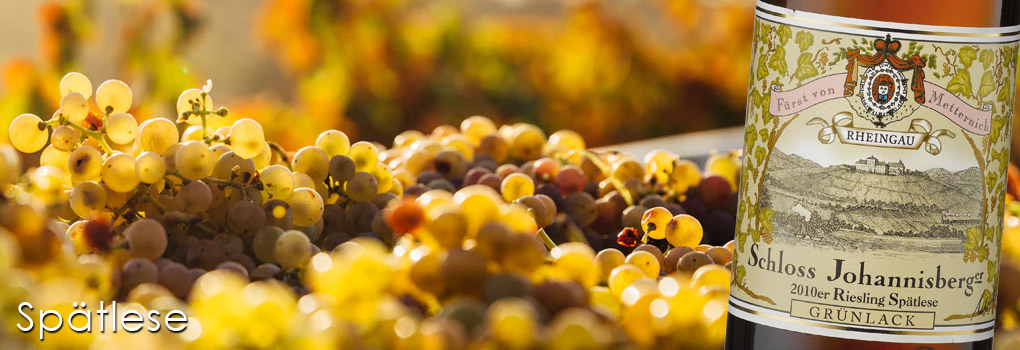
Vendange Tardive:
Vendange Tardive 'VT' - is a French term that means 'Late Harvest' . The term relates to a style of 'sweet dessert wine' where the grapes are left to hang on the vine late into the growing season - until they start to dehydrate and shrivel on the bunch.
This process called 'passerillage' - increases the level of natural sugars in the grape juice and concentrates the flavours within the berry. The winemaking term is sometimes written as 'vendanges tardives' - referring to the fact that several visits / passes through the vineyard occur, harvesting only select bunches and even single berries is often necessary to produce such wines. Alsace wines were the first to be described as Vendange Tardive - but the term is used in other wine regions across France.
Since 1984, the term Vendange Tardive has been further classified in Alsace - and may only be applied to wines that exceed a minimum must weight and pass a blind tasting by the INAO - (National Institute of origin and quality).
Selection de Grains Nobles (SGN) - is an even sweeter level, used for grapes that have been affected by noble rot (botrytis cinerea). Vendange Tardive is also the term and official wine designation for the sweet wines which are produced in Luxembourg.
Since German is a common language in the Alsace region along with French (as Alsace was controlled by Germany 4 times in its history, being again part of France since the end of World War I), the designation Vendange Tardive is often translated literally as 'Spätlese' by the Alsatians. However, the must weight requirement for a 'VT' is higher than for the Prädikat Spätlese classification in Germany or Austria. In wine classification terms, a Vendange Tardive wine from Alsace is more close to a German or Austrian 'Auslese'.
Gewürztraminer is the most common varietal used for Vendange Tardive wines, as it readily achieves high sugar levels. Harder to attain with Riesling and Pinot Gris, but with greater acidity to balance the sweetness, such wines can age for many years. Muscat 'Vendange Tardive' wines are also sometimes seen when vintage conditions are ideal - enjoy.

Vin Doux Naturel:
Vin Doux Naturel - a French wine term translates as 'naturally sweet' - but this is not exactly the case. We are talking about wines made using 'mutage', the addition of grape spirit to the grape must, added before the completion of fermentation. This action kills the yeast, and the unfermented sugar causes the wine to be sweet.
With 'mutage', however, the yeast action is halted by the addition of alcohol, resulting in what is really a blend of wine, unfermented grape juice and added grape spirit.
The most common wine styles involve the varietal Muscat usually 'Muscat a Petits Grains', as in 'Muscat de Beaumes de Venise' and Rasteau AOC, and also Grenache, as in Banyuls an appellation of Roussillon.
This region might be regarded as the birthplace of the vin doux naturel method in France, as it was here, in the 13th Century, that Arnaud de Villeneuve, of the medical school at Montpellier University, perfected the technique. Arnaud a renowned doctor demonstrated that the addition of spirit to the must halted fermentation, and so received a patent from the king of Majorca, who then ruled Roussillon from 1276 - 1311.
Despite this great success, this particular use of grape spirit was of no great interest to Arnaud; like many physicians, he valued the relatively new process of distillation because of the medicinal properties of the alcohol obtained. Yet centuries later, Arnaud's method of mutage remains essentially unchanged.
With Vin Doux Naturel (VDN), the spirit accounts for up to 10% or the final total volume, but it is traditionally a very strong spirit that is added, often around (190 proof); as a result the total alcohol content of the finished wine is typically 15% Alc./vol. Nowadays, the grape spirit is likely to come from either the European wine resource, or possibly from local distillation, but whatever the source, the blending is such to give the final desired ABV in keeping with local tradition and, of course, wine laws. The resulting wines are usually 15% to 18% alcohol but can range as high as 21%. VDNs vary in sweetness, with white wines generally being sweeter and less alcoholic than red wines - enjoy.

Vin Santo:
Vin Santo - (translates to: holy wine) is a unique style of sweet dessert wine from Italy. With its origins in Tuscany, these wines are typically made from white grape varietals such as Trebbiano and Malvasia. But Sangiovese may be used to produce a 'rosé' style known as 'Occhio di Pernice' or (eye of the partridge). The wines can be described as 'straw wines' - since they are often produced by partly drying wine grapes on straw mats in a warm and well-ventilated area of the winery. Some wineries with the space available and racking - still hang the bunches to dry and dehydrate (as shown on the left) before pressing.
Though technically 'Vin Santo' is a dessert wine, the wines can vary greatly in their levels of sweetness: from bone dry to extremely sweet. While this unique wine is believed to have originated in Tuscany, examples of Vin Santo can be found throughout Italy and is an authorised style of wine for several DOC and IGP regions. After the grapes are harvested, they are laid out on straw mats or hung under rafters. They are kept in warm, well ventilated rooms that allow the moisture in the grape to evaporate. This process of dehydration allows the sugars in the grape to be more concentrated.
After fermentation the wine is then aged in small oak barrels. In many DOC wine regions, the wines are required to age for at least 3 years - though it is not uncommon to age these richly flavoured wines for 5 to 10 years.
Traditionally the barrels were made of chestnut instead of oak, which contributed high amounts of wood tannins and was very porous which promoted a high level of evaporation. Towards the end of the 20th century, producers began changing to oak barrels while maintaining the tradition of not topping up the barrels and filling in the ullage space.
Typical flavours often include roast nuts and raisin notes with honey characters. In Italy it is traditional to serve the wine as a digestif at the end of the meal with or after espresso. It is often served with biscotti cookies that may be dunked into the wine. The wines can even be fortified with grape spirit like Port Wine added during fermentation - these fortified examples are usually labeled as Vin Santo Liquoroso - enjoy the journey.
